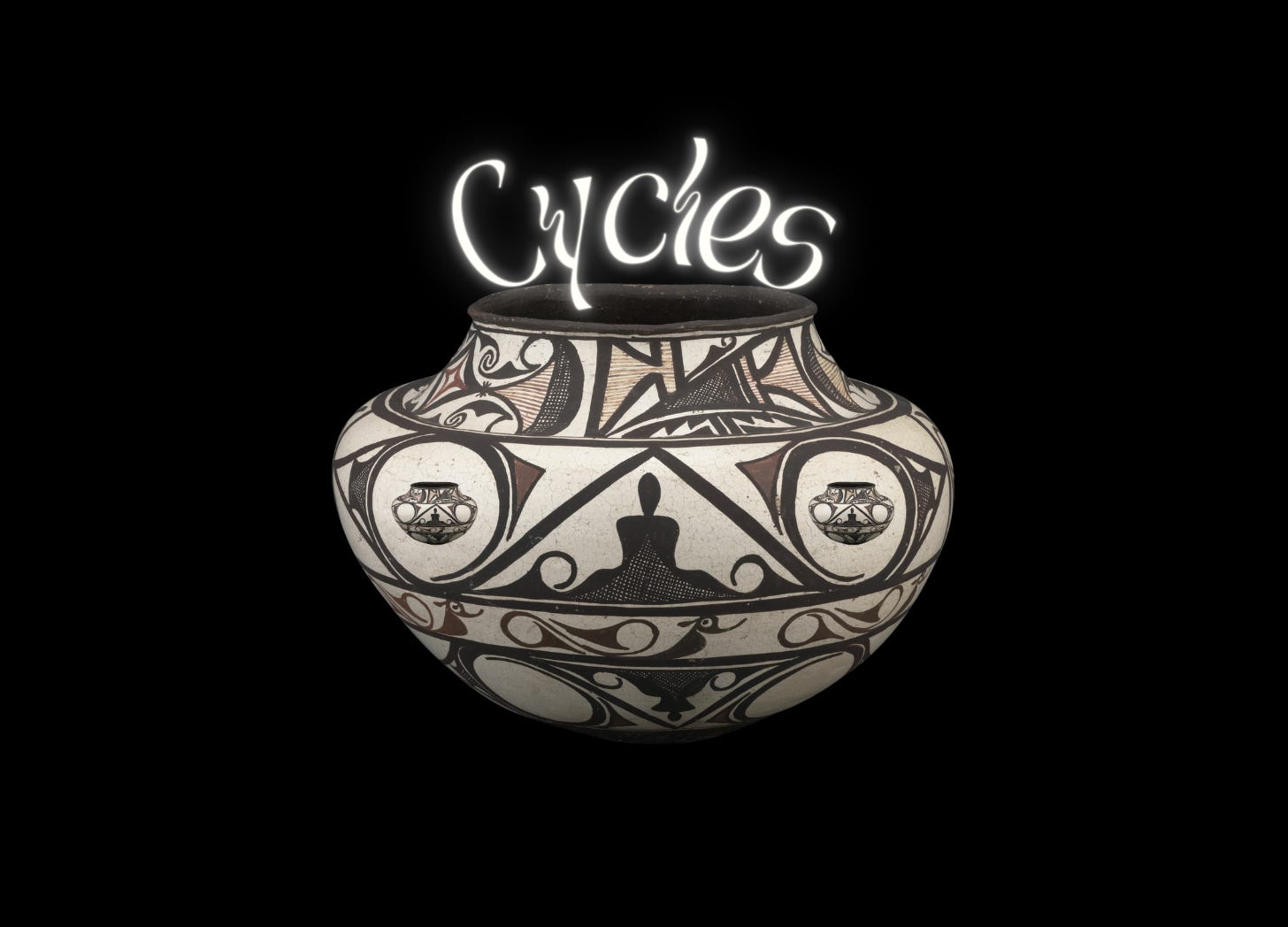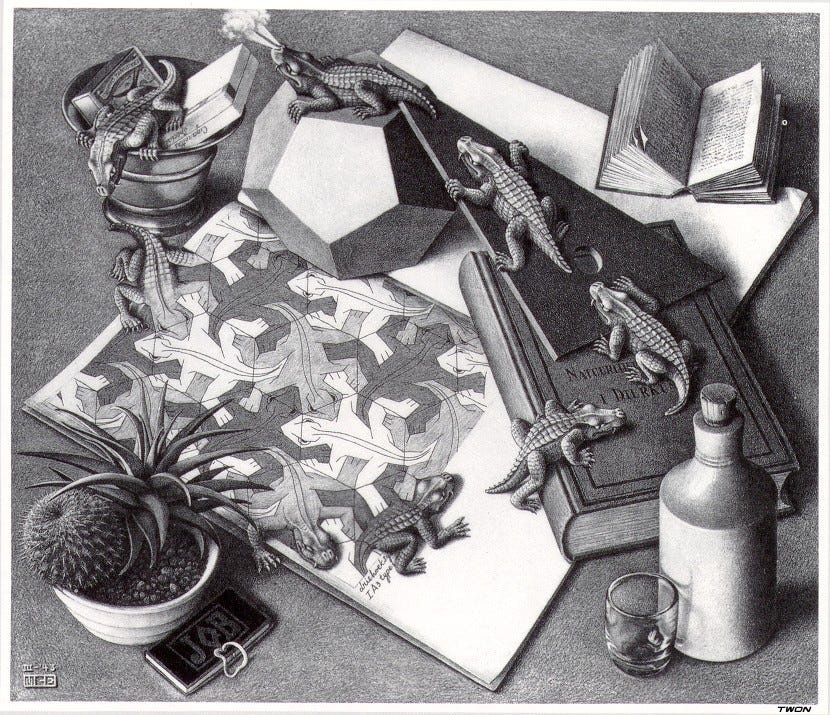cycles
round and round we go!
Dear word explorer,
The cosmos is a mesmerising space. This evening, after I made a spontaneous decision to discuss and name this newsletter cycles, I decided to check in on my favourite solar paparazzi web site, spaceweather.com.
My regular readers know I’m fascinated with the wild behaviour of our Sun during its rumspringa1 year. The badass sunspot AR3664, which caused such spectacular Northern Lights on 10 May, is slowing rotating back into line of sight of Earth.
To celebrate, yesterday it shot out an X2.8-class solar flare with an associated huge CME (coronal mass ejection) which will miss Mercury, Venus, Earth and Mars. Timing is everything! Look at this beautiful NASA model of the event.
As soon as I saw this spinning cosmic wind pattern emanating from the sun (along with violent CME) I thought about the short-lived science fiction TV series, The Time Tunnel, created by Irwin Allen from 1966-1967.
Irwin was later dubbed the ‘Master of Disaster’ for his movies about catastrophic events, the most famous of which was The Poseidon Adventure (1972) and The Towering Inferno (1974). Before The Time Tunnel, Irwin had created TV series Voyage to the Bottom of the Sea (1964-1968) and Lost in Space (1965-1968).
The Time Tunnel is a classic time travel yarn: Dr. Douglas Phillips (Robert Colbert) and Dr. Anthony Newman (James Darren) are two scientists working in a vast underground lab holding a huge time tunnel, which is code-named Project Tic-Toc.2 Under the threat of budgetary cuts (the eternal bad guy of science), Tony enters the tunnel and gets lost in time. His buddy Doug follows, hoping to stage a rescue, but instead they both get thrown into various historic moments during the season’s thirty episodes.3
How do you break the loop once you are caught within the established pattern?
The spinning Time Tunnel became such a trope that it was spoofed in Austin Powers: The Spy That Shagged Me (1997), and although the British had already renewed the love of time travel back in 1963 with the arrival of Doctor Who, the legacy of The Time Tunnel can be seen in some TV series in subsequent decades such as Quantum Leap (1989-1993), Timeless (2016-2018) and Loki (2021-2023). Such is the metafictional era in which we live, many popular time travel shows continue to be recycled.
The Time Tunnel itself spawned novels, comics books and a board game, and finally, a remake in 2002, which resulted in only a pilot episode.
Death and taxes are not the only inevitables in life now: the franchise wheel keeps spinning out replicas in a Sisyphean search for another media jackpot.
Late this afternoon I got into a discussion about the artist Maurits Cornelis Escher (1898-1972), with my husband Martin. We talked and looked at images that we both enjoyed.
Escher was a dazzlingly innovating graphic artist, creating memorable work with woodprints, lithographs and mezzotints that increasingly demonstrated a fascination with repeated patterns, ‘impossible objects’, and mathematical symmetry. One of his important sources of inspiration came from the history of Tessellation via mosaic tiling in the ancient world: including the Sumerians, Egyptians, Persians, Romans, Greeks, Arabs, Japanese, Chinese, and the Moors, although the most exquisite tessellations are perhaps within the Islamic art and architecture tradition.

My history with Escher comes via my younger brother, who repeatedly borrowed the book, M.C. Escher: The Graphic Work, from the library. Since it was in the house I also looked through it often, puzzling over Escher’s patterns and images, and in particular the surreal ones which demonstrated the ability to show different perspectives of the same subject. Many years later I bought the book in a second-hand shop, so I was able to flip through it tonight.
I have been pondering the issue of cycles and patterns a great deal over the past year or so, and in particular how to break from the ones that inhibit or restrict. The great power of any repeated thought, habit, or behaviour is how it sinks into muscle memory. Driving a car for the first few weeks (especially if you drive a gear shift) is an exercise in excruciating heightened awareness and sweaty panic as you make complicated, alien movements while moving through traffic. Quickly, our brain compensates and the new patterns become rote. Which is why it is best to cement good driving habits at the beginning. They will set.
Equally, the terrible detriment of any repeated thought, habit, or behaviour is how it becomes reflexive. Looking in a mirror can spark internal criticism. Frustration is saved up to unleash on loved ones. A tough day justifies inhaling a cake.
What’s difficult about the human condition is the cycles of awareness we have over our dilemmas. Often we see them, address them, and sometimes even shift them, and years later, like a surprise visitor, they turn up with dusty baggage and squat in your upstairs room. They don’t wash the dishes, or help out with chores. No, they point out all that’s wrong in the gaff while raiding the pantry and the drinks cabinet, and maybe even vaping at the threshold of your back door, but never quite stepping outside.
‘Just tell them to leave!’ you are tensely informed, and perhaps you practice the 'Get out’ speech in your bathroom, but once within the orbit of that malingering presence you feel powerless, voiceless and incapable.
‘Reptiles’ is one of my favourite Escher pieces that incorporates a repeated pattern and the mundane world crossed with surreal symbols, infused with a playful spirit.
Escher once said:
The flat shape irritates me — I feel like telling my objects, you are too fictitious, lying there next to each other static and frozen: do something, come off the paper and show me what you are capable of! ... So I make them come out of the plane. ... My objects ... may finally return to the plane and disappear into their place of origin.4
Escher’s reptiles emerge from the 2-D space and appear to take physical existence to clamber over his workspace, huff in impatience, and slither back into the paper.
But it is all a fiction. It is a conjuration, although parts of it seem to exhibit more life than the others.
The book of JOB rolling cigarette papers in the engraving seems like a private joke aimed at the viewer about the need to remain steadfast during the parade of reptiles. They dissipate, revive, and fade away again.
Enjoy your pleasures, get on with your work and pay attention to your passions.
One day, the reptile phase shifting will make a good image, or a story.
According to Britannica: ‘a rite of passage and period of growth in adolescence for some Amish youths, during which time they face fewer restrictions on their behaviour and are not subject to the Ordnung (German: “order”), the specific system of unwritten community norms that governs their sect.’
Each episode was approximately 50 minutes long, so about twenty modern TikToks.
Yes, back then, a season of TV could have 30 episodes, but were all of them good?
Emmer, Michele; Schattschneider, Doris (2007). M.C. Escher's Legacy: A Centennial Celebration. Springer. pp. 182–183.








Oh, man. Somehow I managed to completely miss the existence of TIME TUNNEL (including that it's what Austin Powers was spoofing) and now I feel like I need to see this show. Irwin Allen! His name was on EVERYTHING in the 1970s!
The book of JOB caught me because I'm reading a book at the moment that involves references to the biblical book of Job. But then I googled and discovered the beautiful art nouveau artwork of JOB rolling papers!
I've always loved Escher and how he used optical illusions to point at existential questions of life. Thanks for the great newsletter!